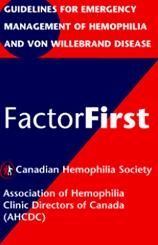Effective immediately masking is required for everyone when present on all inpatient units, in the Emergency Department (ED), the Urgent Care Centre (UCC), and the Children’s Outpatient Centre (COPC).
Resources about Hemophilia for Patients
Hemophilia is a bleeding disorder. People with hemophilia do not bleed any faster than normal, but they can bleed for a longer time. Their blood does not have enough clotting factor. Clotting factors are proteins that control bleeding. Typical symptoms of hemophilia include bleeding into muscles and joints.
Hemophilia is quite rare. Approximately 1 in 5000 males are diagnosed with hemophilia A, and 1 in 30,000 males are diagnosed with hemophilia B. Classically, it was thought that females were carriers of hemophilia, but experienced no symptoms. However, we now know that hemophilia carriers can have abnormal bleeding.
Types of Hemophilia
The most common type, hemophilia A occurs when a person does not have enough clotting factor VIII (factor eight).
Hemophilia B is less common, and occurs when a person does not have enough clotting factor FIX (factor nine). People with either type bleed for a longer time than normal.
Severities of Hemophilia

About von Willebrand Disease
Von Willebrand Disease (VWD) is the most common bleeding disorder, with an estimated 1 in 1000 of the world’s population suffering from it. When a blood vessel is injured and bleeding occurs, a protein in the blood called von Willebrand factor (VWF) helps cells in the blood called platelets, mesh together and form a clot to stop the bleeding. People with VWD do not have enough VWF, or it does not work the way it should. It takes longer for blood to clot and for bleeding to stop.
VWD is generally less severe than other bleeding disorders, however symptoms such as menorrhagia and nose bleeds can be quite debilitating. Many people with VWD may not know that they have the disorder because their bleeding symptoms are mild or overlooked.
Types of VWD
Within each type, bleeding symptoms can be quite variable. Given this variation, treatment must be individualized.
Type 1 VWD is the most common form, and people with it have lower than normal levels of VWF. While symptoms are usually mild, it is possible to have serious bleeding with this type.
Type 2 VWD involves different defects in VWF, which causes the VWF protein not to work properly, resulting in lower than normal VWF activity. Symptoms are usually moderate.
Type 3 VWD is the most serious form, and people with it have very little or no VWF. Symptoms are more severe, including bleeding into muscles and joints, sometimes without injury.
More information about hemophilia and von Willebrand disease is available online from the World Federation of Hemophilia.
Emergency Care Procedure
For guidelines on the emergency management of hemophilia and Von Willebrand disease, please refer to the FactorFirst card, which should be carried by all patients.

Canadian Bleeding Disorder Registry
The Canadian Bleeding Disorder Registry is used by patients who are on home treatment and/or by their caregivers. The goal for this registry is to make it easy for patients and health-care professionals to track patient care, and enable patients to record their bleeds, view their treatment plans, record the use of blood products and update relevant demographic information. If you have questions or concerns please, contact your hemophilia treatment centre. To create a profile, go to MyCBDR.ca.
Hemophilia Ontario - Financial Assistance Program
Financial assistance is available for individuals with inherited bleeding disorders. For more information, including which items can be financially covered, please visit Hemophilia Ontario. You may also complete an application form to request financial assistance.
Women and Bleeding Disorders
The Inherited Bleeding Disorder Program of Southeastern Ontario offers a Women and Bleeding Disorders Clinic the second Wednesday of the month. The multidisciplinary (hematology, gynecology, nursing and research) approach to this clinic allows women who have increased bleeding tendencies to access the best possible treatments and management options.
Additional information:
Let’s Talk Period, a self-administered bleeding assessment tool
Types of inherited bleeding disorders that affect women
Signs and symptoms of bleeding disorders in women
Treatment options for menorrhagia
Gynaecological treatment options for menorrhagia
Conception/pregnancy information
Additional educational resources
Home Infusion
About Home Infusion for Families
Port-A-Cath
Peripheral Vein
YMCA Camp Wanakita
Located near Haliburton, Ontario, YMCA Camp Wanakita is open to all children and youth from seven to 16 years of age. With the help of six hemophilia nurses, children with bleeding disorders learn to self-infuse, and have the opportunity to participate in safe, fun activities while meeting others with and without bleeding disorders. For more information, please contact Alexandra McGillivray at @email or visit the camp website.
